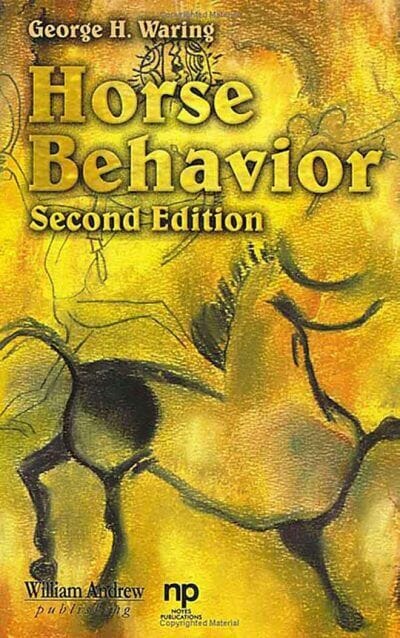PREFACE vii
PART I: INTRODUCTION 1
1. Ancestry of the Horse 3
2. Perception and Orientation 18
Vision 18
Hearing 26
Touch, Pressure, and Thermoreception 27
Smell and Taste 28
Proprioception and Equilibrium 32
Pain 33
Orientation and Homing 34
3. Motor Patterns 36
Reflexes 36
Locomotor Activity 38
Gaits 41
Other Motor Patterns 47
Reactive Distances 60
PART II: BEHAVIORAL DEVELOPMENT 63
4. Ontogeny of Behavior Patterns 65
Perinatal Development 65
Post-Natal Development 71
5. Play 83
Solitary Play 84
Play Between Foals and Their Mothers 85
Play Between Foals and Other Young 87
Play Between Young and Adult Horses 89
6. Investigative Behavior 91
7. Learning and Memory 96
Habituation 97
Classical Conditioning 97
Instrumental Conditioning 98
Latent Learning, Insight, and Social Learning 110
Imprinting 111
Memory 113
PART III: MAINTENANCE ACTIVITIES 115
8. Resting and Sleep 117
9. Ingestive Behavior 124
Feeding 125
Food Selection and Preferences 130
Drinking 136
Nursing 139
10. Eliminative Behavior 144
Urination 144
Defecation 147
11. Comfort Behavior 149
Self-Indulgent Behaviors 149
Sunning 149
Shelter-Seeking 149
Licking 150
Nibbling 150
Scratching 152
Rubbing 152
Rolling 153
Shaking and Skin Twitching 153
Tail Switching 157
Mutual Interactions 157
Mutual Grooming 157
Symbiotic Relationships with Birds and Humans 159
PART IV: REPRODUCTIVE BEHAVIOR 161
12. Sexual Behavior of Stallions 163
Patterns of Stallion Behavior 165
Intensity of Sexual Behavior 169
Stimuli Affecting Stallion Sexual Behavior 173
Abnormal Sexual Behavior of Stallions 175
13. Sexual Behavior of Mares 182
Patterns of Mare Behavior 183
Intensity and Duration of Estrus 191
Control of the Estrous Cycle 192
Intrauterine Saline Infusion 193
Photoperiod Manipulation 193
Hormone Injection 194
Other Manipulations 195
Abnormal Sexual Behavior of Mares 196
14. Maternal Behavior 199
Pre-Parturient Behavior 199
Parturient Behavior 201
Post-Parturient Behavior 203
Abnormal Maternal Behavior 208
PART V: SOCIAL BEHAVIOR 209
15. Social Organization 211
Herd Structure 211
Emigration and Immigration 215
Social Roles 217
16. Social Attachment 219
Mare-Foal Attachment 220
Foal-Mare Attachment 224
Peer Attachment 227
Heterosexual Attachment 229
Paternal Attachment 231
Interspecies Attachment 231
17. Home Range and Territoriality 233
Home Range 233
Territoriality 238
18. Social Dominance 243
Establishing and Maintaining Rank 245
Factors Influencing Rank 247
Influence of Rank Order on Daily Activity 250
19. Agonistic Behavior 253
Alert, Alarm, and Flight 253
Aggression 257
Interactions Between Stallions 262
Submission 264
Abnormal Agonistic Behaviors 267
20. Communicative Behavior 270
Visual Expressions 270
Leg and Body Gestures 271
Facial Expressions 273
Tail and Other Gestures 281
Acoustical Expressions 283
Squeal 283
Nicker 284
Whinny (Neigh) 297
Groan 298
Blow 299
Snort 299
Snore 299
Other Sounds 300
Tactile Interactions 300
Chemical Exchanges 301
PART VI: ECOLOGICAL INFLUENCES 303
21. Interaction of Horses and Their Environment 305
Home Range Preferences and Habitat Utilization 305
Bioenergetic Considerations 307
Influence of Resource Distribution on Territoriality 308
Activity Patterns and Movements 308
Environmental Influences on Time-Budgets 308
Diurnal and Nocturnal Movements 309
Seasonal Movement Patterns 309
Antipredator Strategies and the Use of Sanctuaries 310
Symbiotic Relationships 311
Influence of Horses on Their Environment 313
22. Ecological Influences on Reproduction and
Social Behavior 315
Factors Influencing Parturition 315
Influences on Development, Sexual Maturity, and Dispersal 316
Factors Influencing Social Structure and Stability 318
Influences on Reproductive Success 320
Behavioral and Ecological Factors in Population Dynamics 323
PART VII: APPLIED ETHOLOGY IN HORSE CARE
AND MANAGEMENT 327
23. Behavioral Considerations in Horse Management 329
Enclosures and Housing 329
Social Needs and Human Interaction 332
Exercise and Feeding 333
Grooming and Hoof Care 335
Horse Handling Equipment 336
Transport 336
24. Behavioral Manipulation 340
Early Experience and Human Socialization 341
Training 346
Training Environment 346
Fundamentals of Training 347
Restraint 352
25. Behavioral Indicators Relevant to Health and Well-Being 362
Changes in Expression and Posture 362
Changes in Perception and Orientation 364
Changes in Motor Coordination 364
Changes in Maintenance Behavior 365
Changes in Social Behavior 366
Appearance of Problem Behaviors 366
APPENDIX: VARIETY OF EQUINE BEHAVIORAL
SYMPTOMS AND POSSIBLE PROBLEMS INDICATED 369
Expressions and Postures 370
Perception Changes 374
Orientation Changes 375
Coordination Changes 375
Maintenance Behavior Changes 379
Social Abnormalities 382
Problem Behaviors (Vices) 383
BIBLIOGRAPHY 385
INDEX 415














![Ettinger’s Textbook of Veterinary Internal Medicine 9th Edition [PDF+Videos] Ettinger’s Textbook of Veterinary Internal Medicine 9th Edition [True PDF+Videos]](https://www.vet-ebooks.com/wp-content/uploads/2024/10/ettingers-textbook-of-veterinary-internal-medicine-9th-edition-100x70.jpg)

![Textbook of Veterinary Diagnostic Radiology 8th Edition [PDF+Videos+Quizzes] Thrall’s Textbook of Veterinary Diagnostic Radiology, 8th edition PDF](https://www.vet-ebooks.com/wp-content/uploads/2019/09/textbook-of-veterinary-diagnostic-radiology-8th-edition-100x70.jpg)





